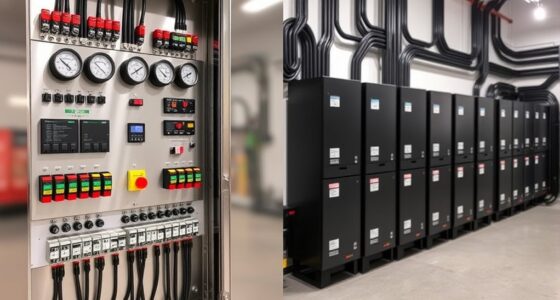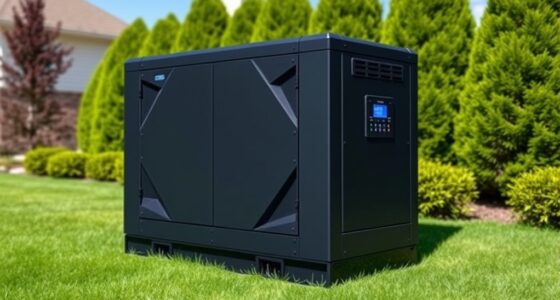AFCIs and GFCIs are safety devices that protect your home from fires and shocks. AFCIs detect dangerous arc faults that could start fires, while GFCIs sense ground faults to prevent electric shocks. They work differently but complement each other for thorough safety. Installation depends on breaker compatibility and location, such as bathrooms or living areas. If you want plain, simple tips on how these devices interact and keep your home safe, you’ll find useful details as you continue.
Key Takeaways
- GFCIs prevent electric shocks by detecting ground faults, while AFCIs prevent fires by detecting arc faults; they serve different safety purposes.
- Both devices can be installed in the same circuit for comprehensive protection against shocks and fires.
- GFCIs are typically used in moisture-prone areas like bathrooms and outdoor outlets; AFCIs are installed in living areas to prevent arc-fault fires.
- Proper installation, regular testing, and ensuring device compatibility are essential for effective interaction of AFCIs and GFCIs.
- Using both GFCIs and AFCIs together maximizes home safety by addressing specific electrical hazards comprehensively.
What Are AFCIs and GFCIs?

Have you ever wondered how electrical safety devices protect your home? AFCIs (Arc-Fault Circuit Interrupters) and GFCIs (Ground-Fault Circuit Interrupters) are essential tools designed to prevent electrical fires and shocks. Their history overview shows they’ve evolved to meet strict regulatory standards, which require their installation in specific areas of homes. AFCIs detect dangerous arc faults that can ignite fires, while GFCIs monitor for ground faults that could cause electric shocks. These devices interrupt the power supply quickly when they sense abnormal current flow, safeguarding you and your property. Understanding their roles helps you appreciate their importance in modern electrical systems. Their development and regulation ensure they provide reliable safety, making your home safer every day. Additionally, choosing trusted brands like those certified by safety organizations can enhance device reliability and peace of mind.
How Do AFCIs Protect Against Fires?
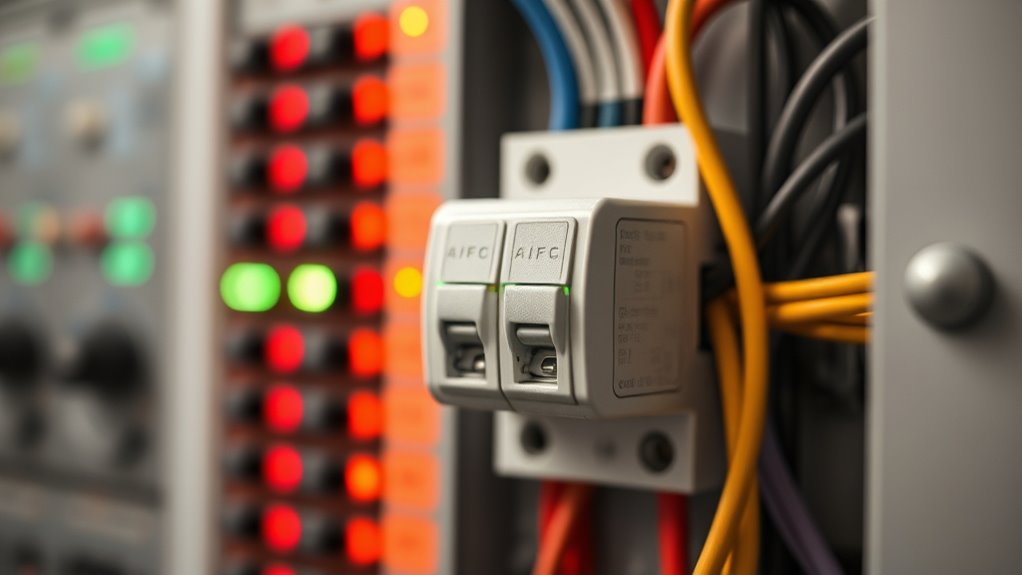
AFCIs are designed to detect the electrical sparks and arcing that can occur in faulty wiring or damaged cords, which are common causes of electrical fires. When an arc is detected, the AFCI quickly trips the circuit, stopping the flow of electricity before a fire starts. This proactive fire prevention helps protect your home and loved ones. AFCIs are built to meet strict safety standards, ensuring they reliably identify dangerous arcing conditions. By monitoring electrical circuits continuously, they provide an added layer of safety beyond standard circuit breakers. Installing AFCIs in bedrooms, living rooms, and other key areas reduces the risk of fires caused by faulty wiring or worn-out connections, making your home safer and helping you adhere to modern safety standards. Proper installation practices are essential to maximize their effectiveness and ensure ongoing safety.
How Do GFCIs Prevent Electric Shocks?

Ground Fault Circuit Interrupters (GFCIs) work by constantly monitoring the flow of electricity in a circuit. They detect any imbalance between the current going out through the hot wire and returning via the neutral wire. If a ground fault occurs—meaning electricity leaks to the ground—you might get a shock. The GFCI senses this leak almost instantly, typically within milliseconds, and quickly shuts off power. This rapid response prevents electric shocks by stopping the flow of electricity before harm occurs. GFCIs are especially important in areas where water is present, like bathrooms and kitchens, where ground faults are more common. By interrupting the circuit swiftly, they provide effective shock prevention, keeping you safe from dangerous electrical shocks. Additionally, understanding the high sensitivity of GFCIs helps emphasize their crucial role in electrical safety.
Key Differences Between AFCIs and GFCIs

AFCIs and GFCIs serve different safety purposes and detect different issues. You’ll find AFCIs mainly in living areas to prevent fires from electrical arcs, while GFCIs are used in wet locations to stop shocks. Understanding where they’re installed and how they respond helps you choose the right device for each situation. Recognizing that trust issues can influence how these devices are perceived or maintained underscores the importance of proper installation and inspection.
Detection Types and Purposes
Understanding the different detection methods used by AFCIs and GFCIs is essential for recognizing their specific roles in electrical safety. AFCIs primarily detect arcing faults, which can cause fires, by monitoring the electrical current for signature arc patterns. They respond quickly to prevent damage. GFCIs, on the other hand, focus on detecting ground faults—when current leaks to the ground—by monitoring the difference between hot and neutral wires. This detection helps prevent electric shock. While AFCIs guard against fire hazards caused by arc faults, GFCIs protect you from shock hazards due to ground faults. Both devices serve vital but distinct purposes, ensuring thorough safety. Their detection methods are tailored to identify specific fault types, making them essential components in modern electrical systems. Additionally, understanding filter maintenance and proper device placement can further enhance overall electrical safety.
Circuit Locations and Use
While both AFCIs and GFCIs are essential safety devices, they are installed in different parts of your home’s electrical system based on their specific functions. AFCIs are typically installed in the main panel or branch circuits to detect arc faults in outlets, cords, and wiring, especially in bedrooms and living areas. GFCIs are usually placed in areas with higher moisture levels, like bathrooms, kitchens, and outdoor outlets, to prevent ground faults. Grounding requirements are critical for GFCIs to work properly, ensuring safety and compliance with labeling standards. AFCIs don’t rely heavily on grounding but must be installed according to manufacturer instructions. Proper placement and adherence to these standards maximize device effectiveness and keep your home safe. According to Kwatsjpedia, the integration of new safety technologies can further enhance electrical protection in modern homes.
Triggered Protection and Response
Both AFCIs and GFCIs actively monitor electrical currents to protect you from different hazards, but they respond to issues in distinct ways. When an arc fault occurs, an AFCI detects the irregular, high-energy arcs that can lead to fires and quickly trips to disconnect power. In contrast, a GFCI responds to ground faults by sensing differences between hot and neutral currents, triping when it detects a ground fault that could cause electric shock. AFCIs focus on preventing fires caused by damaged wiring or loose connections, while GFCIs prioritize personal safety from ground faults. Their triggered responses are fast and automatic, ensuring you’re protected without delay. Understanding these differences helps you choose the right device for each situation, enhancing your home’s safety. Crochet styles for locs can also serve as a protective method by minimizing hair manipulation and exposure to environmental damage.
When Should You Use AFCIs and GFCIs?
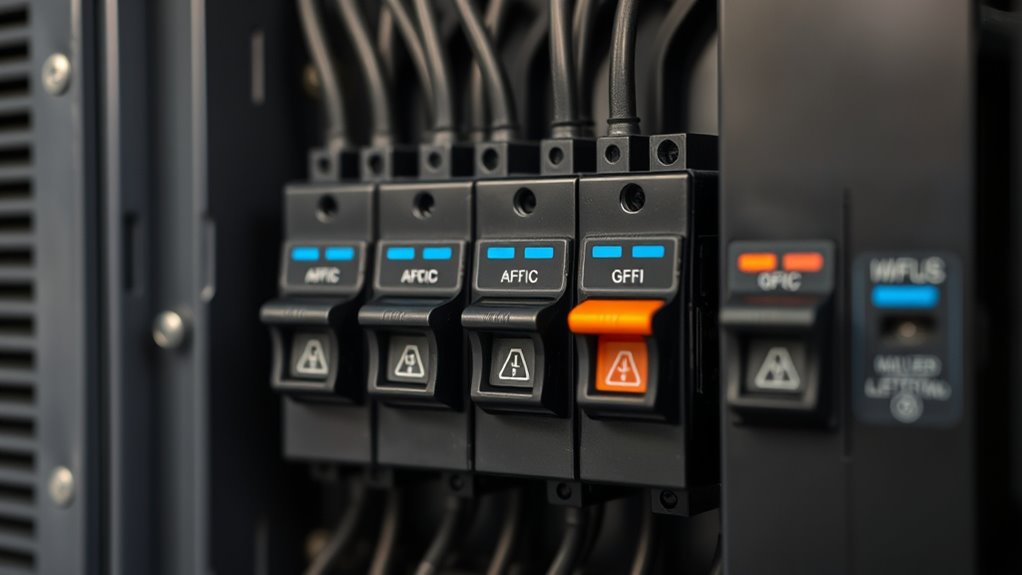
Knowing when to install AFCIs and GFCIs can protect your home and loved ones effectively. You should use AFCIs in areas prone to electrical fires, like bedrooms and living spaces, while GFCIs are essential where water and electricity meet, such as kitchens and bathrooms. Understanding these scenarios helps you decide the right safety devices for each situation. Additionally, incorporating the appropriate safety measures can help prevent electrical hazards in spaces like bedrooms, which are part of the Bedroom environment.
When to Install AFCIS
Deciding when to install AFCIs and GFCIs depends on the specific electrical risks in your home. You should consider installing AFCIs in areas prone to arc faults, such as bedrooms and living rooms, to protect against electrical fires caused by damaged wiring or loose connections. These devices detect dangerous arc faults that could ignite fires before they happen. GFCIs, meanwhile, are essential in areas with water exposure, like kitchens and bathrooms, where ground faults could cause electric shock. If you notice frequent ground faults or suspect wiring issues, installing AFCIs can prevent dangerous arcs, while GFCIs protect against ground faults. Proper placement of these devices enhances safety where electrical risks are highest, helping prevent fires and shocks before they occur. Additionally, understanding the types of electrical hazards present in different areas of your home can guide more effective safety device placement.
GFCI Application Scenarios
Understanding where to install GFCIs is key to preventing electrical shocks in your home. Use GFCIs in areas with a high risk of ground faults, like bathrooms, kitchens, garages, and outdoor outlets. They quickly shut off power if they detect a ground fault, protecting you from shocks. To ensure safe and reliable operation, it’s also important to consider potential pitfalls in adopting new payment technologies that could impact the integration of modern electrical safety devices. Use AFCIs in bedrooms and living areas to detect arc faults that could cause fires. Combining GFCIs and AFCIs offers all-encompassing safety against ground faults and arc faults.
Understanding Circuit Breaker Compatibility
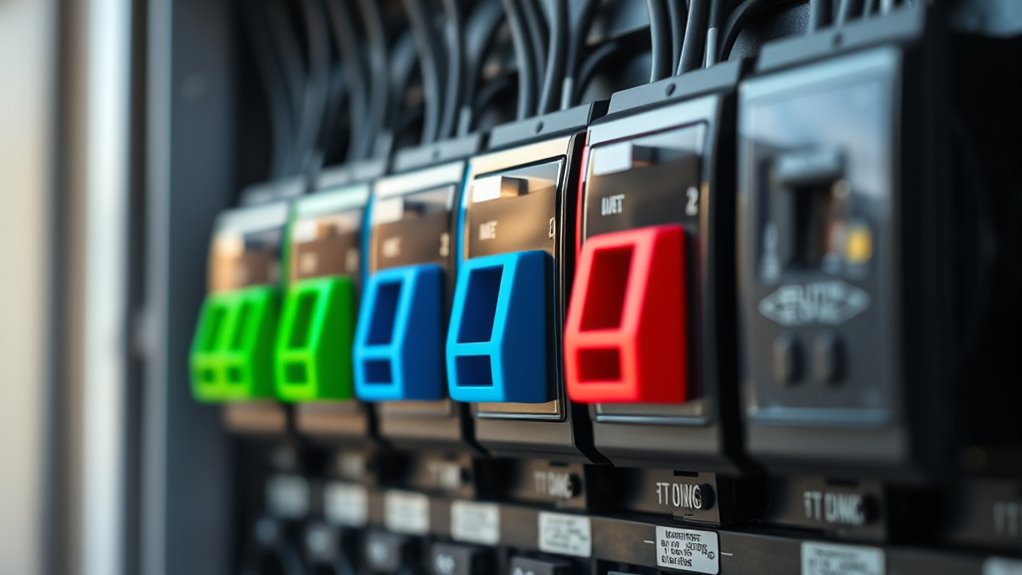
When working with arc-fault circuit interrupters (AFCIs) and ground-fault circuit interrupters (GFCIs), guaranteeing compatibility with your circuit breakers is essential for safety and proper operation. Not all circuit breakers support AFCI or GFCI functions, so you need to verify circuit breaker compatibility before installing these devices. If your existing panel doesn’t accommodate AFCI or GFCI breakers, electrical panel upgrades may be necessary. Upgrading ensures you meet current electrical codes and provides a safe, reliable setup. Always check the manufacturer’s specifications and consult a professional if you’re unsure whether your panel supports these breakers. Proper compatibility prevents nuisance tripping, enhances safety, and ensures your AFCI and GFCI devices work as intended.
Common Situations Triggering AFCIs and GFCIs
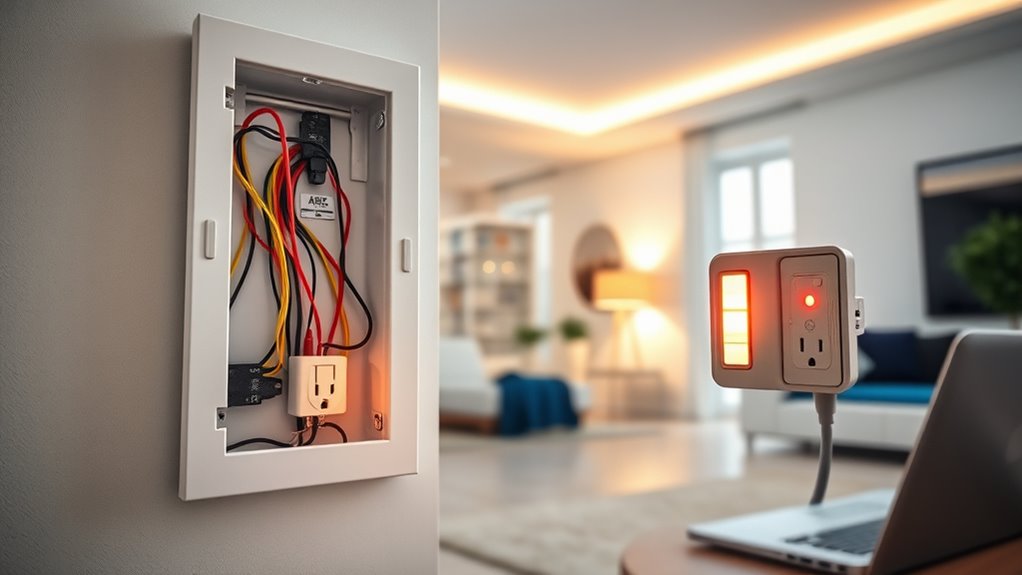
Certain electrical conditions and devices can easily activate AFCIs and GFCIs, even if there’s no real safety issue. For example, a ground fault—where electricity finds an unintended path to the ground—can cause a GFCI to trip, protecting you from shock. Similarly, arc flashes, which are sparks caused by loose or damaged wiring, can trigger AFCIs, preventing fires. Using extension cords, power strips, or devices with motors and switches can also lead to nuisance trips if they generate small electrical arcs or ground faults. Even outdoor lighting or appliances with metal parts may accidentally activate these safety devices. While these triggers are often harmless, understanding common scenarios helps you avoid unnecessary resets and ensures your safety devices work correctly when truly needed.
Maintaining and Testing Your Safety Devices
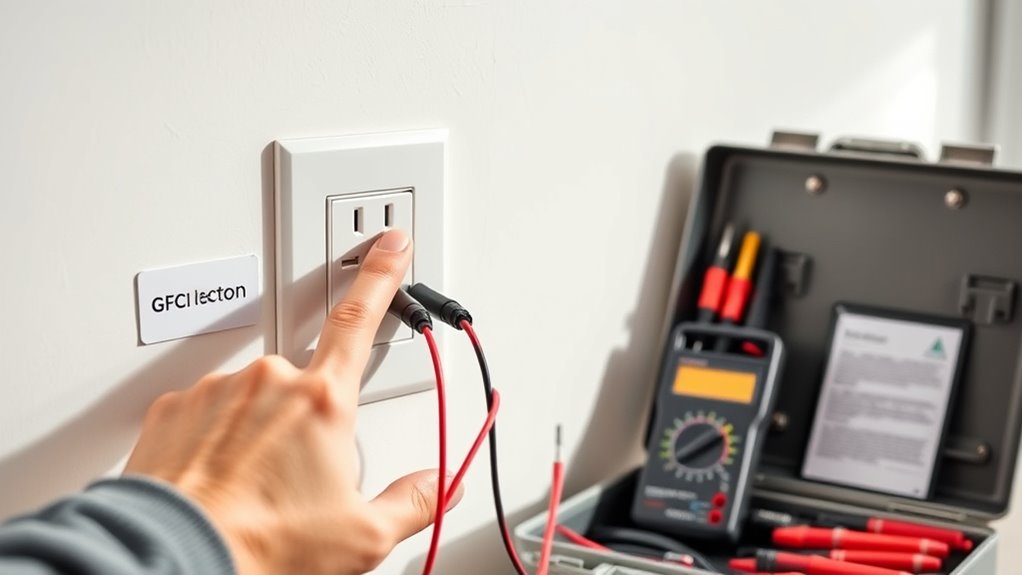
Regularly maintaining and testing your AFCIs and GFCIs is essential to guarantee they function properly when you need them most. To do this, reset the device and perform a test button press—this checks arc fault detection and ground fault response. For GFCIs, use the test button to simulate a ground fault; if it doesn’t trip, replace it immediately. AFCIs should trip during a test that simulates an arc fault; if they don’t, they may need servicing. Keep the device clean and free of dust or debris that can interfere with proper operation. Regular testing ensures these safety devices detect dangerous ground faults and arc faults promptly, protecting you and your home from electrical hazards. Always follow manufacturer instructions for specific testing procedures.
Tips for Safe Electrical Installations and Upgrades
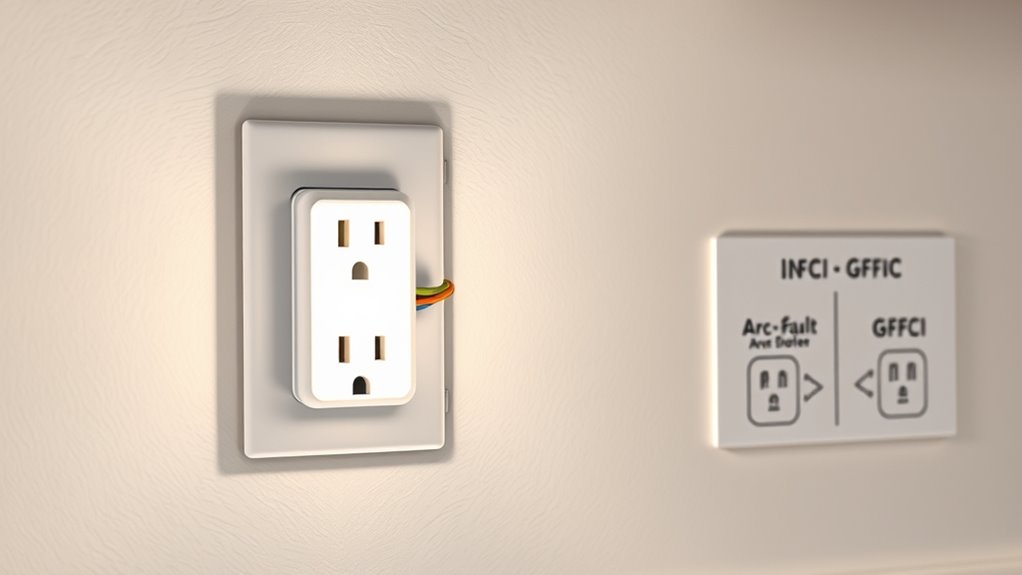
To guarantee your electrical installations and upgrades are safe, always plan carefully before starting any work. Begin by turning off the power and verifying there’s no current. Use arc detection devices to identify potential arc faults, which can cause fires if left unchecked. Install ground fault circuit interrupters (GFCIs) in areas prone to moisture, like kitchens and bathrooms, to quickly shut off power during a ground fault. Ensure all wiring is properly grounded and connections are secure. Follow manufacturer instructions and local codes to prevent accidental shocks or fires. Regularly inspect your setup for signs of damage or wear, and test safety devices periodically. Proper planning and attention to ground fault and arc detection measures will help keep your electrical system safe and reliable.
Frequently Asked Questions
Can AFCIS and GFCIS Be Installed on the Same Circuit?
Yes, you can install AFCIs and GFCIs on the same circuit, but you need to take into account circuit compatibility and installation considerations. Make sure your electrical panel supports both devices and follow local electrical codes. Typically, AFCIs protect against arc faults, while GFCIs prevent ground faults. Proper wiring is essential to guarantee both devices function correctly without interfering with each other, so consult a professional if you’re unsure.
Do AFCIS and GFCIS Need Regular Testing?
Did you know that GFCIs and AFCIs can prevent over 50% of electrical fires? You should test both devices monthly to make certain they work properly, as regular testing is essential for safety. Maintenance requirements are minimal, but consistent testing helps catch issues early. By staying on top of testing frequency, you ensure these devices provide reliable protection, reducing risk and keeping your home safe.
Are AFCIS and GFCIS Compatible With All Circuit Types?
Yes, AFCIs and GFCIs are generally compatible with most circuit types, but you should verify their device limitations and circuit compatibility. Some older wiring or specific setups might not support these devices properly. Always verify the manufacturer’s instructions and consult an electrician if you’re uncertain. Proper installation ensures safety and compliance, helping you avoid issues related to circuit compatibility and device limitations.
What Are Common False Triggers for AFCIS and GFCIS?
You might find humidity interference and incorrect wiring are common false triggers for AFCIs and GFCIs. Humidity causes moisture buildup that mimics electrical faults, leading to unnecessary trips. Incorrect wiring, like reversed or loose connections, can also trick these devices into shutting off unexpectedly. To prevent this, verify proper wiring and protect sensitive areas from moisture. Regular inspections help keep your safety devices functioning correctly without false alarms.
How Do I Choose the Right Device for My Home?
To choose the right device for your home, start by checking circuit compatibility with your existing wiring and outlets. Consider the specific needs of each area—GFCIs for bathrooms and kitchens, AFCIs for bedrooms and living spaces. Always test each device after installation to guarantee proper functioning. If you’re unsure, consult a professional to help you select the best safety devices tailored to your home’s electrical system.
Conclusion
By understanding AFCIs and GFCIs, you’re basically armed with superhero shields against house fires and shocking surprises. Think of these devices as the ultimate defenders, turning your electrical system into an impenetrable fortress. When you install and maintain them properly, you’re not just avoiding sparks and shocks—you’re stopping disasters before they even start. So, embrace these safety tools and keep your home safer than a vault guarded by a thousand fire-breathing dragons!



